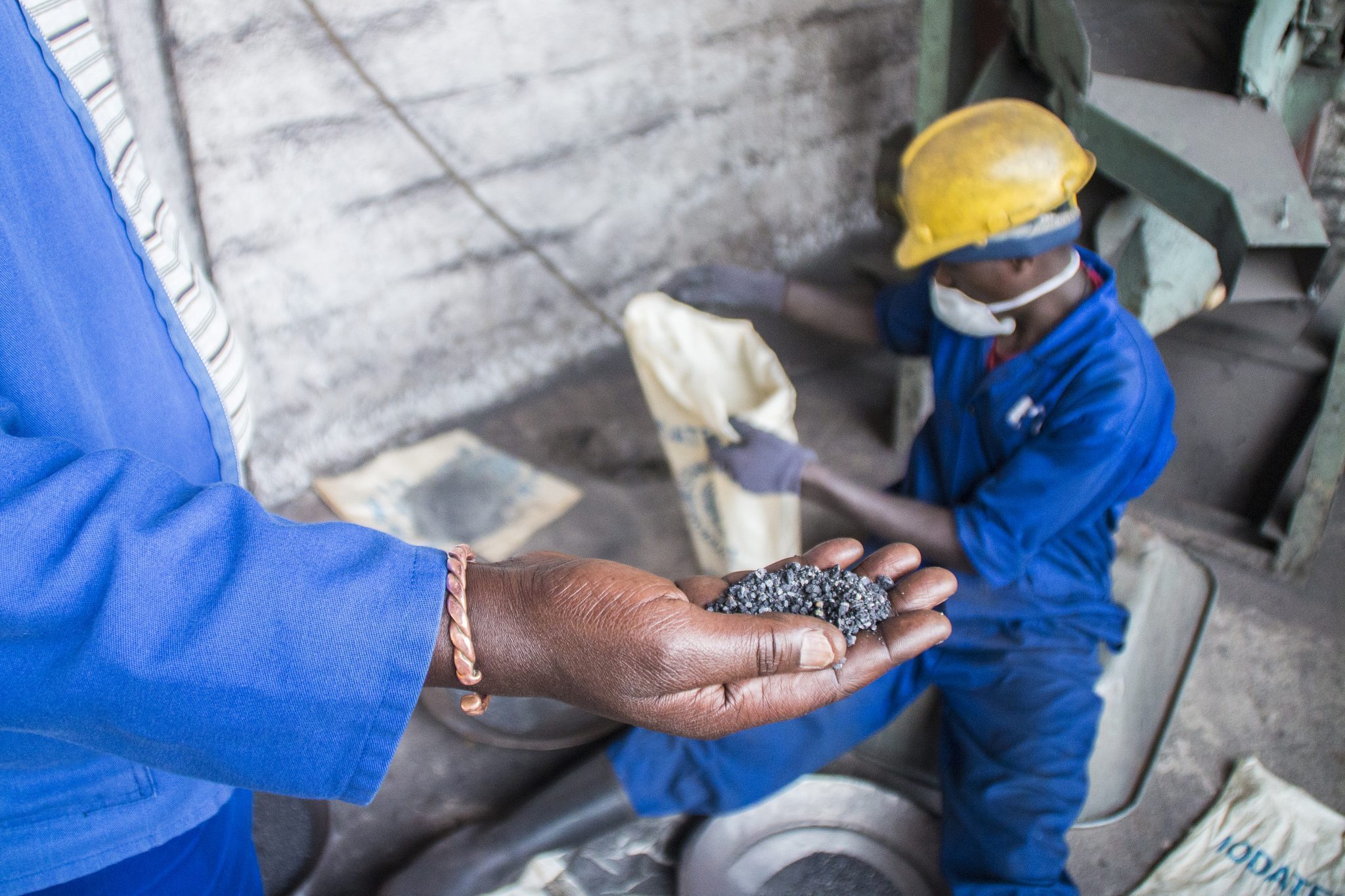Research trip: Visiting tin, tantalum and tungsten mines
In the middle of July, filled with curiosity and anticipation, Bibi and I packed our bags and boarded a flight to Kigali, Rwanda. After a quick stop at a tungsten mine, we got on a smaller plane to the border between Rwanda and Democratic Republic of Congo (DRC) and then continued by road to our next destination: the tin mine in South Kivu, DRC, that provided the tin through the Conflict-Free Tin Initiative (CFTI) for our first Fairphones. During our week-long trip, we circled through the DRC and then back to Rwanda, visiting a total of four different mines.
This trip quite figuratively gave us a deeper understanding of how minerals are sourced, specifically tin, tungsten and tantalum. Besides experiencing the mines firsthand, our goal was to get a more thorough understanding of the route a mineral takes from mine to component and to explore our next steps in adding value throughout the mineral supply chain. To do so, we needed to meet the stakeholders involved and grasp the challenges they are facing. Our visit also provided an opportunity to record what we saw and offer more insight into the mining methods and processes.
For a brief impression of our visit, please take a moment to watch this short film:
Experiencing the difference between artisanal and semi-industrial mines
After visiting the various mining operations, one of our key takeaways was the visible difference between artisanal and semi-industrial mining. Artisanal mining is carried out with minimal or no machinery – meaning it relies primarily on manual labor, with ‘diggers’ creating narrow but deep, steep tunnels. Semi-industrial mines use machinery and mechanisation in operating the mine, but manual labor is still required – in a more organized and structured operation.
Of the mines we have visited, those that are operated by a company are more often semi-industrial mines. Artisanal mining still occurs widely in the DRC, while in Rwanda purely artisanal mining is rare.

Tin: Kalimbi mine site, South Kivu, DRC
In the DRC, we first visited a tin mine in Kalimbi, in the province of South Kivu. This mine supplied the tin used in the soldering paste for the Fairphone, which is part of the conflict-free tin initiative (CFTI). At first glance, the working conditions appear shocking. This mine is purely artisanal, so all the work is done manually and miners burrow through tunnels without (much) protective gear. Production output is lower than semi-industrial mines and health and safety regulations are a challenge to implement at an operational level.
While the conditions seem rather undeveloped, one advantage is that through the Conflict-Free Tin Initiative (CFTI), this mine site is able to export internationally under the Dodd-Frank Act. Being part of the initiative means that the mine is monitored by mining cooperatives together with civil society members and government officials. This was the first (and for a long time, the only) mine site in South Kivu that has been validated as “conflict-free” and has implemented a traceability system (which ensures that the revenue from the mining activities doesn’t finance militias).
As we walked into a tiny wooden office in such a remote area, we were impressed to see a copy of the “OECD due diligence guidance for responsible supply chains of minerals” being studied. And as we talked with the “tunnel captains” on-site, we learned about the awareness among mine workers on the importance of respecting human rights, such as no child labor.
Tantalum: Rubaya mine site, North Kivu, DRC
The other mine site we visited in the DRC is a privately owned conflict-free tantalum mine in the North Kivu province. (To refresh your memory, tantalum is used in capacitors on printed circuit boards). The site we visited combines artisanal with semi-industrial methods. Machines create terrasses or layers, turning the area into an open pit mine. The miners don’t work in dangerous tunnels but outside in the open air, making this method of mining safer for the mine workers. The mine workers at this site also wore protective gear (boots, helmets, etc.).
This level of development already influences the atmosphere at the site and shows a direct impact on the working conditions. The significant differences from the tin mine in South Kivu were immediately apparent. The infrastructure is more advanced and support facilities for the community, like a small on-site medical facility.
At the moment, the conflict-free tantalum in our Fairphones’ capacitors are sourced through the Solutions for Hope initiative and comes from the DRC’s southern province of Katanga, so not the mine we visited. The visit to the mine site in North Kivu enabled us to meet more people in tantalum mining and research for other opportunities for future Fairphones.
Tungsten: Kigali and Musanze sites, Rwanda
Tungsten is a heavy metal that is used in vibration motors (yes, the stuff that makes your phones shake). We visited two tungsten sites in Rwanda – one close to Kigali, and the other close to Musanze. These privately-owned, company-run mines were certainly the safest, most organized semi-industrial mines we saw during our trip. That the overall infrastructure is more developed and mechanized, is apparent for example in the way everyone (including visitors like us) wears appropriate safety gear, like protective clothing, boots and hardhats. The mines are also far more advanced from a social perspective resulting in better working conditions. Currently, a micro-finance and insurance opportunity for employees is also being developed.

Traceability and the importance of conflict-free mining
Whether artisanal or semi-industrial, all of the mines we visited have one thing in common – a traceability scheme to trace the minerals to their source. At each site, every bag of minerals is provided with an uniquely numbered tag to identify the source and then noted in a logbook. These tag numbers are recorded in a database and in the case an incident is reported concerning certain bags, these tag numbers are flagged in this database and cannot be reused. While the system might appear basic, it represents multiple levels of control and requires significant training and a change in mindset for those involved in the trade.


We believe it is essential to continue to support these types of initiatives and not only source from “easier” regions where no conflict exists.
However, a comment from local stakeholders is that very few mine sites can afford resources (eg, money, infrastructure, location) to implement a traceability scheme, even though they have been validated conflict-free. A lack of a strong, sustained demand or traceable export routes, often drive these artisanal miners into illegality. Local, national, regional and international actors must work together to provide proper incentives and develop necessary infrastructure for due diligence and responsible mining in these remote sites. Potential negative effects of legislation should be addressed so that the income from the mineral trade spurs greater stability and development for the mineworkers and surrounding communities.
Moving beyond conflict-free for even greater impact
The semi-industrial mines that are mostly privately owned show progressive development in terms of working conditions and health and safety measures, which in turn proves that more responsible sourcing from the African Great Lakes Region is possible. However, the working conditions in the artisanal mines that have been validated conflict-free in the DRC, are still far from optimal. It is important to keep in mind that responsible mining requires a step-by-step process to get people trained and familiarized with traceability and transparency measures to effectively implement basic human rights principles.
Drawing awareness to the issues in the mining sector and using conflict-free minerals was our first step. So far, we have managed to incorporate conflict-free tin and tantalum in our phones. For our next phone we hope to incorporate additional conflict-free minerals like tungsten, but that also depends on identifying manufacturers that are willing to use these minerals in the components we require. We also want to move beyond conflict-free to make an even greater impact on local communities. That means finding responsible business partners who are addressing the issues in mining at a broader scale, including child labor, health and safety, wages and general working conditions. As we continue to explore the options, we’ll be sure to keep you updated.



